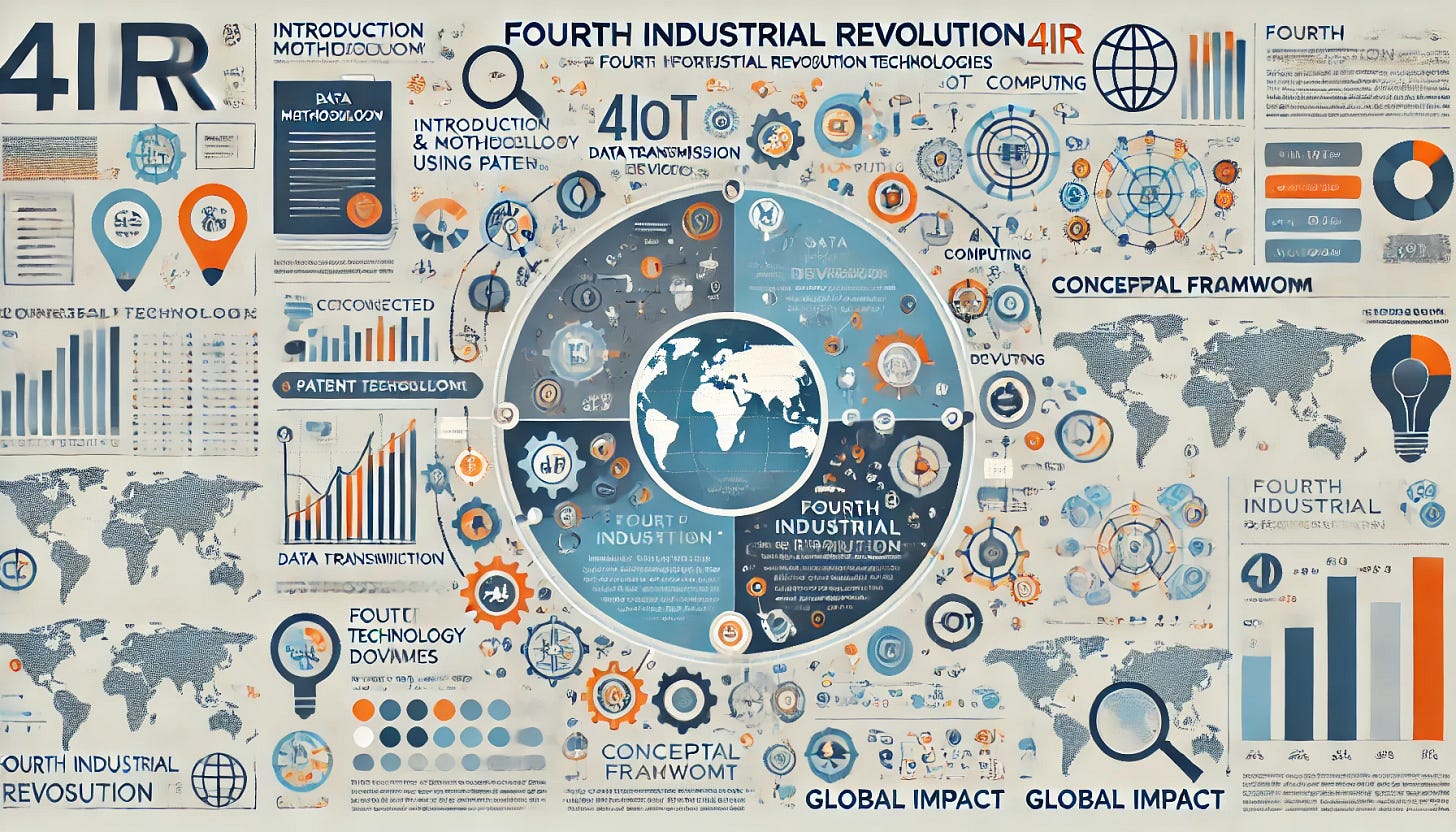Identification of Fourth Industrial Revolution Technologies Using PATSTAT Data
Authors: María de las Mercedes Menéndez, Önder Nomaler, Bart Verspagen Journal: UNU-MERIT Working Papers No. 023
Introduction 🚀📚📈
Menéndez, Nomaler, and Verspagen present a detailed examination of methodologies used to identify technologies associated with the Fourth Industrial Revolution (4IR). Leveraging patent data from the comprehensive PATSTAT database, the authors implement a rigorous analytic procedure. This procedure integrates keyword searches within patent titles and abstracts with strategic classifications derived from the Cooperative Patent Classification (CPC) scheme, widely used in patent analysis.
Contextualizing the Challenges of 4IR Technology Identification 🧩🌐🤔
The identification and classification of 4IR technologies are confronted with numerous methodological complexities, reflecting broader theoretical and practical challenges:
Conceptual Ambiguity: Significant disparities exist across scholarly, industrial, and policymaking communities regarding the exact composition and scope of 4IR technologies. These disparities hinder the development of a universally accepted taxonomy.
Sectoral Convergence: A defining feature of 4IR technologies is their integration and interdependence across multiple industrial sectors. This inherent cross-sectoral interaction complicates attempts at precise classification.
Semantic Overlaps and Fluid Terminology: Frequently, the terminology associated with 4IR technologies is overlapping, interchangeable, and fluid, complicating the establishment of clear conceptual boundaries.
Dynamic Technological Evolution: The rapid and iterative advancement in technological fields associated with 4IR necessitates continuously adaptive identification methods, presenting significant methodological challenges.
Conceptual Framework for Defining 4IR Technologies ⚙️🔗💡
The authors propose an integrative conceptual framework that views 4IR technologies as dynamic, interlinked technological systems composed of innovations from four fundamental technology domains:
1. Digital Data Transmission: This domain includes technologies that enable swift, secure, and large-scale data exchange, integral to the functionality and coherence of digital ecosystems.
2. Smart and Connected Devices: Encompassing sensor-based technologies, embedded systems, and comprehensive IoT networks, these innovations facilitate advanced interactions between devices, environments, and users, significantly enhancing both responsiveness and functionality.
3. Computing Innovations: Major advancements in computing technologies are integral to 4IR. Artificial intelligence (AI), machine learning (ML), deep learning frameworks, neural networks, fuzzy logic, and cloud computing platforms collectively enhance data analysis, processing capabilities, and operational intelligence.
4. Communication Technologies: This group includes significant developments in wireless communication networks, mobile communication systems, and advanced internet protocol technologies. These technologies underpin connectivity, interoperability, and real-time communication capabilities essential for integrated technological systems.
Detailed Methodological Approach 🔍📝📂
The methodology employed by Menéndez, Nomaler, and Verspagen builds upon and significantly expands the European Patent Office's (EPO) foundational approach. It integrates two primary analytical strategies:
1. Keyword-Based Patent Searches: The authors systematically conducted targeted keyword searches within the titles and abstracts of patents. The carefully curated keywords encompassed a broad spectrum of critical 4IR technology concepts, including data transmission technologies, IoT infrastructure, sensor technologies, smart home solutions, augmented reality (AR), artificial intelligence, cloud computing platforms, internet infrastructures, mobile technologies, and wireless communication protocols.
2. Patent Classification Using CPC Codes: In conjunction with keyword analysis, the research team applied a rigorous selection process of CPC codes, strategically identifying classifications closely related to core technologies in digital data transmission, computing, and wireless communications. This dual approach substantially enhanced the precision and representativeness of the resulting dataset.
Key Empirical Findings and Analytical Insights 📈🌎📌
The integrated methodological framework yielded several important empirical insights:
Marked Increase in Patent Activity: The study documents a pronounced increase in global patent activity related to 4IR technologies, particularly emphasizing innovations in digital connectivity, smart home systems, consumer electronics, and IT hardware. These trends underscore accelerated global diffusion and adoption rates.
Geographical Concentration of Innovation: Patent activity demonstrates significant geographical concentration, predominantly clustering within South Korea, China, and the United States. These countries exhibit clear strategic advantages, attributed to targeted innovation policies, robust institutional frameworks, and considerable R&D investment.
Specialization Patterns: Leading innovator countries display distinct yet interconnected patterns of specialization, reflecting highly developed capabilities and extensive interdisciplinary innovation activities. This highlights the importance of integrated knowledge bases and innovation ecosystems in driving technological progress.
Broader Implications for Policy, Industry, and Research 🌐💼🔬
The findings and methodological contributions of this research hold substantial implications across multiple domains:
Policy Development and Strategic Planning: Policymakers can utilize the detailed methodological framework to identify strategic areas for investment, prioritize research funding, and formulate more targeted innovation and technology policies.
Industry Applications: Industry stakeholders can strategically leverage the insights from patent trends to refine their R&D strategies, anticipate technological shifts, and maintain competitive advantages in rapidly evolving markets.
Advancement of Research Agendas: Academic researchers benefit from a transparent and reproducible analytical tool, enabling deeper exploration into technological convergence patterns, innovation trajectories, and socio-economic impacts associated with 4IR technologies.
Conclusion 🏁📖🔑
The methodological framework presented by Menéndez, Nomaler, and Verspagen provides a substantial advancement in addressing the complexity of identifying Fourth Industrial Revolution technologies. By combining robust keyword analysis with precise CPC code classification, their methodology ensures the accurate and comprehensive identification of relevant patents. The replicability, transparency, and systematic nature of this approach represent significant contributions to academic research, policy formulation, and strategic technological management across diverse sectors and contexts.
To watch video please click here
Curious to learn more? Check out the full study here.
To connect:






